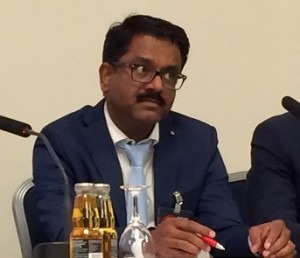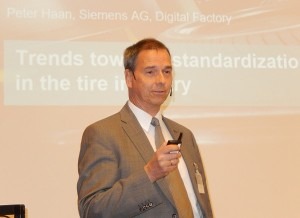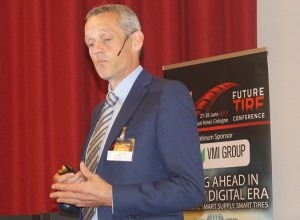Industry must adopt new attitudes and openness towards the potential opportunities of digitalisation, top-level speakers emphasieed at this year's ERJ Future Tire Conference in Cologne:
The need to forge new relationships between tire companies, equipment suppliers and system vendors was a recurring theme at this year’s Future Tire Conference, which focused on the adoption of advanced automation technologies in the industry.
Setting the scene at the event held 27-28 June in Cologne, Germany, Apollo Tyres‘ head of automation and electronics Shibu George said that despite all the major technology-led changes over the last 50 years, industrial productivity had not improved.
Even today’s internet, social media and e-commerce platforms, said the Apollo executive, had “affected the way we sell and buy, but not improved our productivity.”
In the fourth industrial revolution (Industry 4.0), he said, the challenge is to combine existing manufacturing technology with new IT technologies to deliver higher levels of process control and better meet tire market requirements.
“Connecting up the machinery is not enough, the Apollo keynote speaker emphasised. “We need to reduce the gap between machines and other activities. That is what is more important.”
These views were echoed by Peter Haan, head of vertical market management tire at Siemens AG’s Digital Factory Division. For him, the main challenges for machine builders and tire makers concern how to implement integrated, digital technologies at operational and organisational levels.
Implementing these many interfaces and functions requires a lot of software, said Haan, advising that the tire industry should adopt more holistic and standardised approaches in this area.
“A standardised operating philosophy works independent of the supplier,” said Haan. “Operators and other data users should have identical information about the machine situation [so that] no misinterpretations are possible.”
To advance this approach, Siemens is now offering the ‘tire community’ a library comprising basic, standardised representations of mechanical, electrical and automation elements.
The modular library was developed following discussions with machine builders, tire makers and component suppliers and is based on Siemens’ TIA automation platform.
The library standard is focused on the whole tire manufacturing process – upstream, mixing, downstream, tire building, curing presses, tire inspection – and is useable at any tire manufacturer or OEM.
Basic library objects include valves, motors, drives, inverters and PID controls, while plant-specific objects – provided by OEMs – typically include dosing units, mixers, calenders and conveyors,
A simulation feature, meanwhile, enables testing of the machine parts, so for example, users can learn how a HMI operates or optimise equipment before it actually exists.
In summary, Haan said Siemens’ standardisation approach could make the journey to a digital tire plant easier, adding that standardisation of PLC code, automation code and of software is an essential part of this.
“We all have to work together to get to a ‘magic triangle’ of tire manufacturers, machine builders and system integrators,” Haan’s presentation concluded.
In a subsequent Q&A session, Haan revealed that Siemens is in discussions with HF and a “big German tire manufacturer” about implementing some machines based on this library. If successful, he said, the standardised system will become mandatory for all machines at this tire company.
“This is what we offer to all the other OEMs and end users because, I think, tire manufacturers can really save a lot of money from using such a standard,” said Haan.
Mixing room
For HF Mixing Group, it is a “strategic goal” to invest heavily in automation in order to increase efficiency in the mixing room, set out Hans-Martin Monyer, responsible for automation at the German tire and rubber equipment major.
As part of this automation programme, HF has established a group of engineers that concentrates solely on developing industrial software, which is required to be stable, quality-tested and reliable.
“HF has established a kind of life-cycle process to bring software always up-to-date,” said Monyer. “We believe that obsolete software is still an underestimated risk in the tire industry and in the rubber industry in general.”
Having built up a huge library of data on different mixers, HF has also developed software to calculate throughputs required for specific tire production runs – to keep the mixer working efficiently. There are also packages to estimate manufacturing cost per mixing line and optimise workflow in the mixing room.
HF has recently set up a ‘3D database’ to analyse and present library data: by location, by mixing line, by production order, recipes, time and label data. This can provide data on individual or multiple mixing lines, and even multiple locations.
The next step, said Monyer, is to generate a 3D layout of the complete plant to help customers make decisions and reduce risk around selection of and investment in mixing equipment.
Sharing data
Furthermore, HF is working to establish two-way sharing of machine-status data with customers using localised cloud applications.
“Today we cannot compare the data from one machine to the other, from one customer to the other,” Monyer explained. “What we would like to do in the future is to collect this type of equipment information.”
To that end, HF has developed a ‘process data firewall’ that takes out all process-related and production-related data, and collects only equipment-status information from different mixing lines into a single database.
With such data, Monyer said “we can put it into a predictive analytics model and try to predict if there is a failure on a specific device, if there is a failure coming up in production. Therefore, we really need more data [and] would like to gather all the equipment information from different plants.”
As well as enabling customers to better predict downtime and spare parts requirements, these capabilities would help HF to optimise its manufacture of spare parts and reduce delivery times for items such as rotors and mixing chambers.
“So if we know that 50 mixing chambers will be worn out within the next six or seven months we could start to manufacture them,” said Monyer, pointing out that HF plans to start up a pilot project in this area by the end of this year.
“We hope that we can convince customers to participate in this in order to have a community, he concluded. “Getting this industrial mixing community together to collect data will benefit all of us.”
Smart tires
Jan Grashuis, vice president of global R&D at VMI, said that while many parts of the tire manufacturing and supply-chain process provide data that helps optimise use of materials and machine-time, “what is really new” is that you now get data from the tire.
At the Dutch tire-building machine maker, “we know our products, our sales channels, our customers but we now get a lot more information from the use of the end products,” said Grashuis – noting that this was particularly the case for truck tires.
There is, he suggested, a need for an extra layer of control between the MES and the machine to connect them and access more information about the tire production process.
Grashuis cited recipe-management as an example: “In a tire plant the recipes are often different for every machine. If you had to change something on a machine, you could [control] that centrally and manage all machines with much more control over your production site and over your recipes.”
Taking this point further, Grashuis said that recipes could be extended so that they work in every different type of tire-making equipment. By managing them centrally, these recipes could be sent to build the same tires on any type of equipment.
The VMI expert also envisaged opportunities to enhance control of equipment-management, tracking of the performance of machines, checking components loaded into the machine as well as in logistics and stock-management.
But what is even more important is that all these steps will generate large amounts of data, continued Grashuis.
“Then it really becomes interesting to do the data-crunching, to find correlations and learn things about the process and relations in your process that you didn’t know about,” he said. “That is the point at which you will start to benefit from new technology and improve the way you work.”
This could even lead to self-optimising machines based on information learnt from sensor data, suggested Grashuis: “We are not there yet, we are doing tests but this is something that will happen in the coming years.”
But while there is a lot going on around connectivity, production technology and tire technology, Grashuis cautioned that “if you don’t control your processes, if your tire design is not right, it is all useless.
“The base is still very good tire design, very good compounds, and very good equipment.”
Report based on article in the September/October issue of European Rubber Journal print magazine










